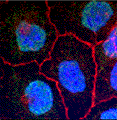Biochemistry, Department of
Document Type
Article
Date of this Version
3-2005
Abstract
The recessive Arabidopsis thaliana fumonisin B1-resistant (fbr6) mutant was identified by its ability to survive in the presence of a programmed cell death (PCD)-inducing fungal toxin FB1. The fbr6 mutant also displays altered plant architecture in the absence of FB1, most notably elongated petioles and enhanced leaf margin serration. These phenotypes are a result of a T-DNA insertion in the SQUAMOSA promoter binding protein (SBP) domain gene, AtSPL14. AtSPL14 encodes a plant-specific protein with features characteristic of a transcriptional regulator, including a nuclear localization signal sequence, a plant-specific DNA binding domain (the SBP box), and a protein interaction motif (ankyrin repeats). A transiently expressed fusion of the AtSPL14 protein to green fluorescent protein is directed to the plant nucleus. DNA sequences immediately upstream of the translation start site direct expression of the β-glucuronidase reporter gene primarily in the vascular tissues, consistent with the phenotypes of the fbr6 mutant. AtSPL14 activates transcription in yeast, with a transactivation domain residing within the N-terminal region of the protein. Recombinant AtSPL14 protein binds A. thaliana genomic DNA in vitro in the absence of other proteins. These results indicate that FBR6/SPL14 functions as a transcriptional regulator that plays a role not only in sensitivity to FB1, but also in the development of normal plant architecture.



Comments
Published in The Plant Journal 41:5 (March 2005), pp. 744–754; doi: 10.1111/j.1365-313X.2005.02334.x Copyright © 2005 Blackwell Publishing Ltd. Used by permission.